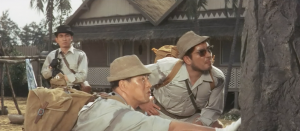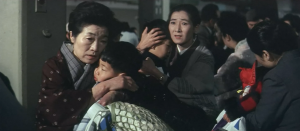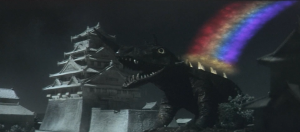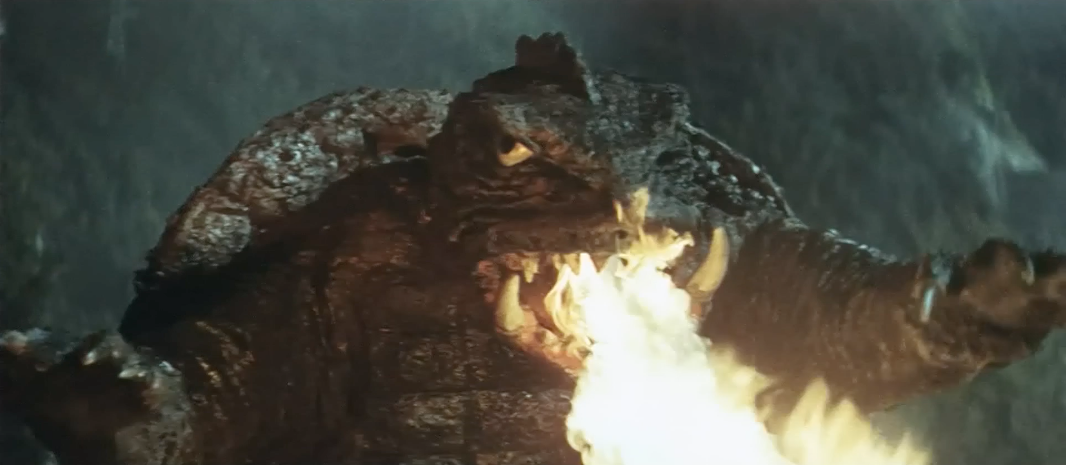Exploring themes of greed and its terrible consequences, Gamera vs. Barugon is an entertaining, if sometimes slow, Gamera outing. Perhaps the best of the original Showa run of Gamera films, Gamera vs. Barugon mixes interesting human drama with a menacing lizard monstrosity, and marks Gamera’s first colour appearance.
The scheming Onodera (Kōji Fujiyama), oblivious Keisuke (Kojiro Hongo), and chipper Kawajiri (Yuzo Hayakawa) are sent by a World War II veteran to an island in the South Pacific to retrieve a large opal hidden during the war. After venturing into the ‘valley of rainbows’ (called so and feared by the island residents) Onodera lets Kawajiri die and leaves Keisuke for dead. Onodera then takes the opal and returns to Japan. Keisuke wakes to find he’s been taken care of by Karen (Kyoko Enami), an island resident. En route to Japan, Onodera accidentally exposes the opal to infrared rays, exacerbating the growth of the organism within: Barugon. Karen and Keisuke return to Japan, armed with knowledge that could help stop the now-giant lizard.
The film’s depiction of greed is a little two-dimensional. Koji Fujiyama’s Onodera is very straightforward in his self-serving ways. However, what works is that the film leans into that presentation, and creates a genuinely unlikeable antagonist in the process. When Onodera accidentally blurts out that he killed Kawajira and Keisuke, he murders the veteran and their wife. The short brawl before Onodera kills the pair is devoid of humour, especially when he hits the veteran’s wife in a stark moment. Scenes like this may not round out the character, but they succeed in eliciting an emotional response to such wickedness.

What’s unique here is that one of the main protagonists is part of the depiction of greed. Unlike Toho’s Mothra (1961) or Mothra vs. Godzilla (1964), wherein the main characters stand clearly opposed to the greed around them, Gamera vs. Barugon presents us with a lead (Keisuke) who shares culpability for the arrival of the monster, Barugon.
What Gamera vs. Barugon has therefore, is an interesting look at guilt and shame. These emotions define Keisuke’s actions for the rest of the film. In turn, they make him a more interesting character, one who feels the weight of the destruction Barugon brings. Indeed, the whole film carries emotional material with a respectable maturity. A quiet moment in which Keisuke looks over a photo of the deceased Kawajiri’s wife and child is markedly upsetting. This character perspective makes Keisuke unique, his guilt stirring him to action, and to realise his redemption.
An air of cynicism and bleakness pervades much of the film, best illustrated in a scene in a shelter in Osaka as Barugon ravages the city above. Tranquil koto music on the radio juxtaposes the terrified faces of mothers grasping their children. A man’s casual gripe about “another atomic bomb” is stark. This is on top of a range of characters whose motives are grimly self-serving.

Gamera looks great in this film. With a permanent scowl, Gamera genuinely looks as if he hates Barugon, adding delicious excitement to the beasts’ encounters. Barugon’s design is simple in construction. He is, for all intents and purposes, a large lizard. But it’s the ingenious choices made with Barugon’s powers that truly make him a worthy foe for the titanic terrapin. From his back, Barugon can launch a rainbow death ray, obliterating all it touches. From his mouth, Barugon’s tongue extends to spray a jet of ice, freezing all before it. These powers and their use in the film come almost entirely without warning, raising the stakes in a surprising fashion.

The film maintains a slow pace throughout, and it’s a big detractor. The human drama and the monster sequences are engaging, but they become stifled after Barugon appears because the film indulges in military meetings about stopping the beast. While this means we’re eventually treated to some great sequences, such as Barugon destroying several missiles using his rainbow death ray, these preceding scenes are a bit tedious.
Whilst elements such as its pace can detract, Gamera vs. Barugon presents an entertaining story with interesting themes. Some of its characters may be thinly constructed in their motives and morality, but that also allows the film to really embellish just how cruel and villainous they are. The remainder of Gamera’s Showa outings would develop to entertain children first and foremost, and the grim tone of Barugon wouldn’t be seen again until the series’ reboot in the 1990s. That said, Gamera vs. Barugon deserves another look, the tonal black sheep of the Showa Gamera era.

